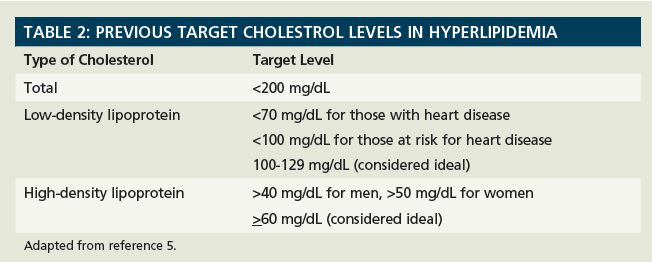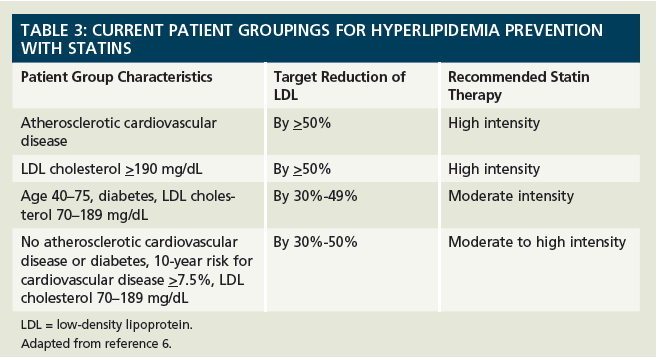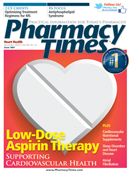Publication
Article
Pharmacy Times
Hyperlipidemia: Updated Guidelines Impact Counseling
Author(s):
Lifestyle and dietary factors are the leading causes of hyperlipidemia.
Lifestyle and dietary factors are the leading causes of hyperlipidemia.
Consider this: Fats and oils accounted for approximately 45% of calories consumed in the 1960s; during that decade, 13% of adults were obese and less than 1% had diabetes. Current data indicate that fats and oils account for 33% of calories consumed today, yet 34% of Americans are obese and 11% have diabetes.1 Clearly, attempts to increase the awareness of cholesterol in the United States have not been tremendously successful (Table 1).2
Numerous factors fuel hyperlipidemia, but lifestyle and diet are the leading culprits. Likewise, certain medications (eg, some birth control pills, diuretics, b-blockers, some antidepressants, and HIV medications) can negatively impact cholesterol levels.3,4
Treatment Guidelines: Past and Present
For the past 10 years, treatment guidelines for hyperlipidemia have advocated a treat-to-target approach. The clinical goal was to treat patients until they reached the recommended target cholesterol level (Table 2).5
New guidelines from the American Heart Association, American College of Cardiology, and the National Heart, Lung and Blood Institute were published in 2014.6 The most significant change is that patients are no longer treated simply to reach specific target levels. This shift is based on insufficient evidence that better outcomes are associated with designated target cholesterol levels. For example, there is no evidence that a patient with coronary disease who has a low-density lipoprotein (LDL) cholesterol level of 78 mg/dL will have a better outcome if his or her target LDL level decreases to 70 mg/dL. The new guidelines do not abandon the importance of lipid levels, but treatment targets are now defined as a percentage from baseline readings.

Patient Groupings
Today’s guidelines define 4 groups of patients for primary and secondary prevention of hyperlipidemia and, for each group, a recommended intensity level for statin therapy (Table 3). Statin therapy is now considered the first-line treatment for lowering cholesterol levels. Other cholesterol-lowering agents such as fibrates, bile acid sequestrants, and niacin are reserved for patients who are statin intolerant or for when statins fail to reach the desired outcome.7
These groupings more accurately define patients who are most likely to benefit from statin therapy. As with all guidelines, patient groupings help guide clinical practice but do not replace clinical judgment. Table 4 defines high-, moderate-, and low-intensity statin therapy.6
The guideline that is generating the most controversy is treating patients with LDL cholesterol levels ranging from 70 to 100 mg/dL and whose risk for heart disease exceeds 7.5%. Critics question the role of treatment for those with low LDL cholesterol levels. They also note that the coronary risk score is heavily weighted by age, blood pressure, and smoking status.8 Readers can access the American Heart Association’s online risk calculator at https://www.heart.org/ gglRisk/main_en_US.html.

Counseling
Evidence demonstrates that intense and comprehensive hyperlipidemia counseling results in greater changes in behavior. Counseling should begin with an assessment of the patient’s understanding of hyperlipidemia, including LDL cholesterol, high-density lipoprotein (HDL) cholesterol, and triglycerides. The pharmacist can explain the difference between good fats and bad fats. If the patient is taking cholesterol-lowering agents, the pharmacist can review side effects and discuss the new guidelines, emphasizing that there is no “magic” number.
It is also important to emphasize that a healthy diet and exercise may be sufficient to reduce cholesterol without medication. Daily caloric intake from fat should range from 25% to 35%, and calories from saturated fat should be less than 7%. Replacing trans fats with polyunsaturated fats is the most effective measure for improving blood lipid profiles.9 When exercise is combined with a diet low in saturated fat, LDL cholesterol levels can be reduced by 7% to 15% and triglycerides by 4% to 18%, with a 5% to 18% increase in HDL cholesterol. Online Table 5 provides additional counseling guidelines.1,4,10,11
Dr. Zanni is a psychologist and healthsystem consultant based in Alexandria, Virginia.
TABLE 5: COUNSELING FOR PATIENTS WITH HYPERLIPIDEMIA
· Emphasize that medication to lower cholesterol is not a license to eat an unhealthy diet.
· Review the consequences of high cholesterol, including heart attack, atherosclerosis, stroke, and vascular disease.
· Recommend frequent cholesterol screenings. Some guidelines recommend screening beginning at age 20. Others recommend the first screening for men at age 35 and for women at age 45.
· Discuss tobacco cessation. Quitting smoking can increase HDL up to 10%.
· Encourage physical activity.
· Stress weight reduction. For every 6 pounds lost, HDL increases by 1 mg/dL.
· Motivate patients to read food labels.
· Recommend limiting intake of saturated fats by cutting back on red meat and full-fat dairy products and increasing omega-3 fatty acids (eg, cold-water fish, walnuts, canola or soy bean oil, flax seeds).
HDL = high-density lipoprotein.
Adapted from references 1, 4, 10, 11.
References
1. Fats and cholesterol: out with the bad, in with the good. Harvard School of Public Health website. www.hsph.harvard.edu/nutritionsource/fats-full-story/. Accessed November 17, 2014.
2. Cholesterol fact sheet. Centers for Disease Control and Prevention website. www.cdc.gov/dhdsp/data_statistics/fact_sheets/docs/fs_cholesterol.pdf. Accessed November 17, 2014.
3. HIV and hyperlipidemia. AIDSinfo website. http://aidsinfo.nih.gov/education-materials/fact-sheets/22/66/hiv-and-hyperlipidemia. Accessed November 17, 2014.
4. Dugdale III DC. High blood cholesterol levels. MedlinePlus website. www.nlm.nih.gov/medlineplus/ency/article/000403.htm. Accessed November 17, 2014.
5. Mayo Clinic Staff. Cholesterols levels: What numbers you should aim for? Mayo Clinic website. www.mayoclinic.org/diseases-conditions/high-blood-cholesterol/in-depth/cholesterol-levels/art-20048245. Accessed November 17, 2014.
6. Stone NJ, Robinson JG, Lichtenstein AH, et al. 2013 ACC/AHA guideline on the treatment of blood cholesterol to reduce atherosclerotic cardiovascular risk in adults: a report of the American College of Cardiology/American Heart Association. Task Force on Practice Guidelines. J Am Coll Cardiol. 2014;63(25 Pt B):2889-2934.
7. O’Riordan M. New cholesterol guidelines abandon LDL targets. Medscape website. www.medscape.com/viewarticle/814152. Accessed November 17, 2014.
8. O’Riordan M. ACC, AHA update guidelines for the treatment of high cholesterol. Available at www.medscape.org/viewarticle/813659?src=emailthis. Accessed November 6, 2014.
9. Kelly RB. Diet and exercise in the management of hyperlipidemia. Am Fam Physician. 2010;81(9):1097-1102.
10. Mayo Clinic Staff. HDL cholesterol: How to boost your ‘good’ cholesterol. Mayo Clinic website. www.mayoclinic.org/diseases-conditions/high-blood-cholesterol/in-depth/hdl-cholesterol/art-20046388. Accessed November 17, 2014.
11. Hyperlipdemia. Southern Illinois University School of Medicine. www.siumed.edu/surgery/vascular/hyperlipidemia.html. Accessed November 17, 2014.







